#4g spectrum
Text
Currently in 4G hell.
Spectrum is doing "routine maintenance" and they're "sorry for any inconvenience".
Gee thanks Spectrum for cutting out our internet when I was playing FFXIV. At least I wasn't doing my roulettes. 🤬
Update: Internet came back a little while ago.
0 notes
Text
Premian a Personal Argentina por ofrecer la red de Internet móvil más rápida
Personal Argentina, empresa de servicios de conectividad fija y móvil de la compañía Telecom Argentina, fue galardonado por la firma Ookla con el premio a la red móvil más rápida de la Argentina, en el marco de la edición 2023 del Mobile World Congress, el mayor encuentro global de las comunicaciones móviles, que se realizó en la ciudad catalana de Barcelona.
(more…) “”
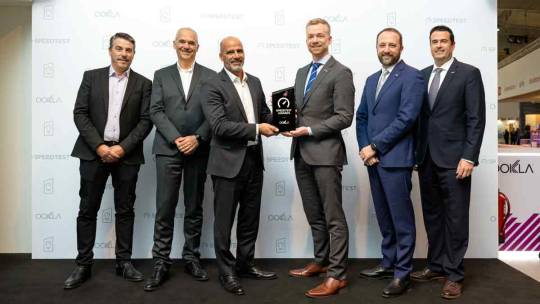
View On WordPress
#4G#4G+#5G#Argentina#Barcelona#Buenos Aires#Córdoba#Corrientes#Doug Suttles#DSS#Dynamic Spectrum Sharing#Internet#Mobile World Congress#Ookla#Personal#Personal Argentina#Posadas#Red#Roberto Nobile#Rosario#Santa Fe#Speedtest#Telecom#telecom argentina
0 notes
Text
BSNL will give tough competition to private companies in 5G, know when this service will be rolled out
BSNL will give tough competition to private companies in 5G, know when this service will be rolled out
highlights
BSNL will get 5G spectrum worth Rs 62,000 crore.
Government can allot 700 Mhz band to BSNL.
At present, the 700 MHz band is only with Jio.
New Delhi. Bharat Sanchar Nigam Limited (BSNL) will get 5G spectrum worth Rs 62,000 crore from the Department of Telecom (DoT). This will be in addition to the Rs 1.64 lakh crore relief package announced by the government earlier this year. Apart…
View On WordPress
#5G Spectrum#5G Spectrum for BSNL#BSNL#BSNL 4G#BSNL 5G#bsnl 5g auction#bsnl 5g plans#bsnl 5g service#bsnl 5g sim#bsnl 5g sim price#BSNl 5G Spectrum#bsnl 5g wifi#companies#competition#give#government to reserve 5G spectrum for BSNL#private#rolled#service#tough#When will BSNL 4G launch? bsnl 5g launch date
0 notes
Text
#5G spectrum service#5G coming soon#5G spectrum 10x faster than 4G#latest news#trending news#apctnews#apctgroup
0 notes
Text
EE adds over 400 new small cells to increase 4G capacity and reduce congestion in the busiest areas
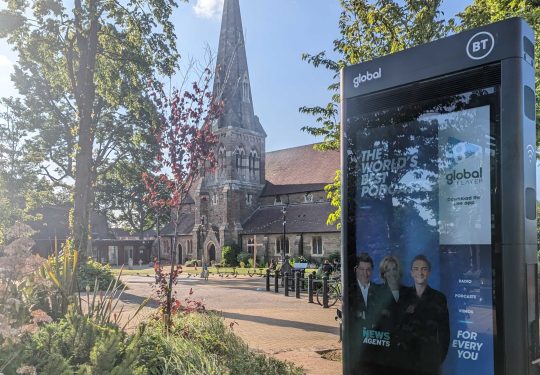
EE has now successfully deployed over 600 street-level mobile sites, known as small cells, across the UK, delivering on its commitment to add hundreds of new sites to the 200 announced just over one year ago.
A further 411 small cell installations are now delivering enhanced capacity in high demand areas, including in major cities such as Birmingham, Brighton and Sheffield, ensuring customers can take advantage of download speeds of up to 300Mbps even at the busiest of times.
Other new locations to benefit from EE’s ongoing small cells deployment include the cities of Swansea, Leicester, Coventry, Wolverhampton, Southampton and York. Meanwhile a host of seasonal hotspots have also received a timely connectivity boost ahead of the Summer, including Newquay, Paignton, Salcombe, Southend-on-Sea and Clacton-on-Sea.
Small cells take advantage of existing street assets, such as BT’s iconic red telephone boxes, to help enhance street-level mobile coverage in busy areas where it’s impractical to build larger sites, such as city-centres and transport hubs. As well as being located on phone boxes, lamp posts and CCTV columns, EE has installed approximately 60 small cells on BT’s innovative new digital Street Hubs, further maximising the benefit of these assets to communities.
EE’s 611 small cell sites currently carry 20TB of data traffic every day – the equivalent of streaming 8,000 hours of HD video or 280,000 hours of music – demonstrating the substantial value they offer to customers in high demand areas, as well as the importance of EE’s strategy to build prior to the arrival of any congestion whenever possible.
Sites are identified via advanced network analytics, which highlights specific locations that would most benefit from the performance boost enabled by a small cell. Then, working alongside Nokia, EE deploys a 4G small cell solution which couples its licenced 1800MHz and 2600Mhz spectrum with unlicenced 5GHz spectrum to deliver standout speed and capacity.

James Hope, Director of Mobile Radio Access Networks, EE: “As demand for data continues to rise, small cells are becoming an increasingly integral part of our mobile network. Our partnership with Nokia ensures customers continue to benefit from our fastest 4G speeds even at the busiest times and in the most congested of locations, and we’re proud to pass another milestone in this project as we continue to invest in improving the UK’s best mobile network* up and down the country.”
Mark Atkinson, SVP, Radio Access Networks PLM at Nokia: “Nokia has an extensive portfolio of high-capacity outdoor and indoor small cells that deliver premium 4G and 5G network performance in dense urban and in-building environments. This latest deployment will ensure that EE’s customers benefit from seamless connectivity particularly in congested or high-demand areas at multiple cities across the UK. We are delighted to continue our partnership with EE and support their ambition to deliver the country’s best network.”
EE’s continued network investment will see hundreds more small cells deployed in the coming months, both in existing and new towns and cities. EE is also trialling the extension of small cells to accommodate its 5G network, with Nokia’s AirScale portfolio able to seamlessly upgrade to 5G.
Last year, EE announced its first such small cell deployments, which brought additional 4G capacity to cities including Leeds, London, Manchester, Newcastle, Edinburgh, Glasgow, Liverpool, Nottingham and Scarborough.
In Newcastle, EE has worked with the City Council to deploy over 20 small cells so far, making use of existing street furniture to boost capacity in busy locations including the city centre, Newcastle University, and in proximity to St James’ Park stadium.
Cllr Alex Hay, Newcastle City Council cabinet member for a Resilient City: “We’re really pleased to be working with EE to improve infrastructure and increase digital connectivity across the city. Matchdays see more than 50,000 people concentrated in a small area, and anyone who has attended football matches and other large events will know it can be difficult to obtain a mobile signal in those environments. By enabling the use of our assets for EE to deploy small cells, we’re boosting connectivity and giving residents and visitors alike an improved experience in our city. We’re proud of our reputation as a leading smart, modern city and are always willing to work with others to further develop local infrastructure.”
*Rankings based on RootMetrics® UK and metro RootScore® reports: H2 2022. Tested with best commercially available smartphones on 4 national mobile networks across all available network types. Your experiences may vary. The RootMetrics® award is not an endorsement of EE. Reports at RootMetrics.co.uk. Visit ee.co.uk/claims for more details.
Read the full article
3 notes
·
View notes
Note

I think you'll like this
Yep pretty much!
Building drones, Skynet and just the threat of mutli-millionares to basic society, who's very existence faculties inequality in society. List can go on.
Honestly, on my trip to Yellowstone on a car trip, my aunt and mom had a arguments with my brother-in-law and sister about social mobility, inherited wealth, inequality etc. My aunt kept on saying that we didn't have anyone in our social circles who made it and became really wealthy; that's why we don't like the system. My mom kept giving the example of immigrants. My brother-in-law kept bringing up facts like there are structures in place that the capitalist class; getting a small loan of $50,000 from their parents those types of examples.
I had to point out that theses facts were not mutually excusive to one another; no person is an island. Just me being the peacekeeper in my fam.
Yesterday, I had to debunk my aunt 5G conspiracy theory's nonsense; its just basic electromagnetic spectrum science at the high school level. Asking just simple questions like: ok, if she has such a problem with 5G, why not with 4G or microwaves, or radio; all tech that she uses. Its non-ionizing radiation, so no it does not cause cancer!
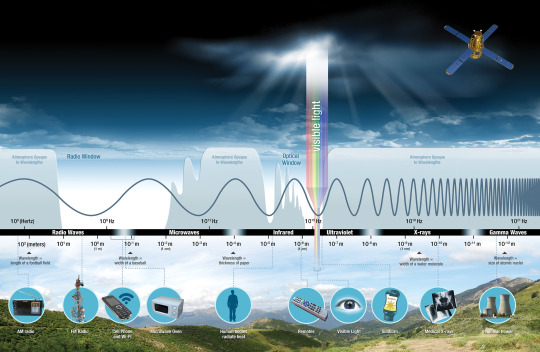
Me with my aunt:

2 notes
·
View notes
Text
Brazil moving ahead with 2G, 3G shutdown
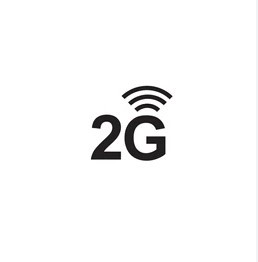
Brazilian telecom regulator Anatel opened a consultation process to collect observations on plans to shut down 2G and 3G networks and transfer spectrum used by those technologies to 4G and 5G.
The process was launched Tuesday, as published in the country's federal gazette.
Operators from other countries in the region, such as Puerto Rico, Colombia and Chile, have already begun this shutdown process, as reported by BNamericas.
At the same time, the Brazilian watchdog vows to curb the certification of cellphones and other equipment made to run only on the legacy technologies, a request that has been made by both operators and chipset manufacturers such as Qualcomm.
Continue reading.
#brazil#politics#brazilian politics#economy#telecommunications#mod nise da silveira#image description in alt
1 note
·
View note
Text
Today is Not About 5G! Today is About 6G Technology? Really? "YES"
I know we are not still over with 5G technology! Now Immensphere is discussing 6G technology? Yes, it is about 6G technology today!
Okay! lets us go into the detail.
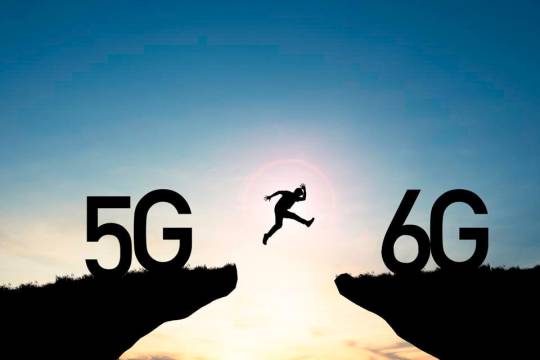
If you live in a country like India, Russia, or Mexico, you must be thinking, we haven’t even seen 5G yet, and you are talking about an overview of 6G technology.
Yes, that is because 72 countries, such as South Korea, the USA, China and Japan, had already launched 5G back in 2019, and now the world is headed towards 6G, the next decade’s technology.
The upgradation in technology from 5G to 6G will be much higher and faster than what we saw in the transition from 4G to 5G.
To understand better about 6G, We have discusse about 5G also.
So 5G vs 6G
Low latency
5G: 5 milliseconds.
6G: 1 microsecond.
Speed
5G: 40 Up to 1,100 Mbps.
6G: Up to 1 Tbps. (1,000,000 Mbps)
Spectrum
5G: 0.4 GHz and 114 GHz.
6G: 95 GHz to 3 THz.
Does 6G Exist?
Currently, 6G is in its initial research and development stage.
Leading telecom companies like Samsung and Qualcomm are working on it and have published research on 6G.
Next is 7G Technology?
What we know is very little about 7G and are only speculations compared to the previous networks while knowing little about the division for 6G.
But we know, when G's technologies will be launched.
5G Technology has been launched in 2020.
6G Technology will be launched in 2030.
7G Technology will be launched in 2040.
*according to reports.
Whatever G's Technology comes out, it will make things super fast, instant, and everything will be just available without a moment.
For now, Immensphere is signing off about 5G, 6G and 7G Technology!
Follow @immensphere for more content like this.
#5g technology#6g internet#telecommunications#telecom#technology#immensphere#services#it services#samsung#qualcomm#south korea#japan#united states#russia#china economy#india#narendra modi
4 notes
·
View notes
Text
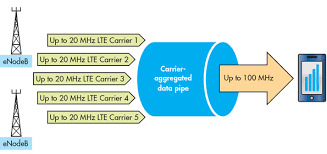
(10-8-22 image ©gadgetstouse.com) Carrier aggregation is the technology that allows the mobile operator to combine a number of different carriers, frequencies if you wish, into a single aggregated wave. This technology has been available in 4G but it is difficult to implement in a real world situation.
BT or rather EE have a number of frequencies available in a similar part of the spectrum that they could use with this technology. They have available frequency in the range 2.1, 2.6, 3.4, 3.6 GHz. Some allocated for 3g, some 4G and some 5G. They have demonstrated carrier aggregation over these frequencies first in the lab and then out in a trial. Maybe not the first do do this or something similar but a step forward.
Whilst Carrier aggregation is good, it does indicate that fewer wider bands would be better than more narrower bands. Something OfCom will need to sort out.
3 notes
·
View notes
Text
For 5G and Wi-Fi router solutions, MediaTek and Invendis collaborated
In order to provide 5G and Wi-Fi router solutions, chipmaker MediaTek and a global pioneer in IoT platforms and cloud computing solutions, formed a strategic partnership on Sunday.
The partnership will allow India to develop a wide range of solutions and important industrial capabilities.
Satish Kulkarni, CEO of Invendis, stated in a statement, “We are happy to unveil our 5G and Wi-Fi routers which will allow consumers and corporate clients to deliver safe, powerful and smooth wireless networking solutions.
Kulkarni continued, “We are convinced that this collaboration would promote innovation, hasten the implementation of 5G goods and services in India, and assist users in taking advantage of the opportunities presented by very fast and dependable connection.
The new “Silboa product line” expands Invendis’ range of industrial and commercial communication solutions by adding 4G/5G routers that support Wi-Fi 4/5/6 standards as well as multi-WAN, VPN, SD WAN, NMS, and other business-specific functions.
MediaTek’s Networking and Connectivity products are included in the product line, including the MediaTek MT7628K/N/A Router and Repeater Platform, the MediaTek MT7621A/N Dual-core Network Processor for 2×2/3×3/4×4 Wi-Fi platforms, and the MediaTek MT7915 Wi-Fi 6 Wave 1+ chipset builds, among others.
Anku Jain, Managing Director of MediaTek India, stated that “MediaTek’s whole spectrum of Networking and Connectivity solutions is geared to satisfy changing client requirements whether it residential, commercial, or corporate applications.”
Earlier, on 1st October 2022, PM Modi introduces 5G services and claims it is the start of an endless sky of possibilities.
5G is the fifth-generation technological standard for broadband cellular networks in telecommunications. It is the anticipated replacement for the 4G networks that connect the majority of modern smartphones, and cellular phone operators started rolling it out globally in 2019.
Source links – MediaTek and Invendis collaborated For 5G and Wi-Fi router solutions
3 notes
·
View notes
Photo
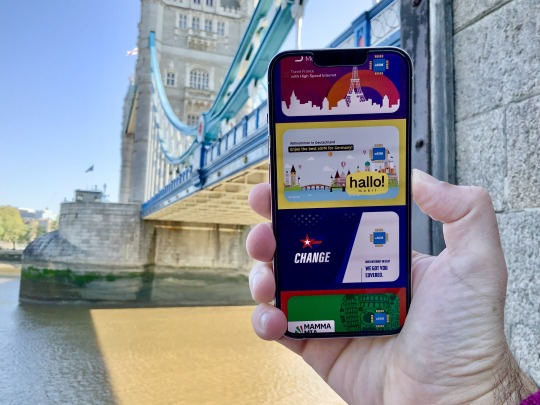
Why eSIM is my new best friend
Data roaming fees are my enemy.
Alternative title: How and why to install an eSIM to save money on data roaming fees when overseas. Especially useful if you have an iPhone 14 with no SIM Tray.
I’ll keep this brief. People travelling overseas often fall into two categories:
1. Pay whatever your phone carrier lots of $$ for data roaming 🤑💸
2. Buy a local SIM card at the airport or downtown after arriving 🤓🏙
The first is easy, but costly. The second is sensible, but can be time consuming.
There’s a much better option that now exists; and middle-ground that is easy enough, and cheap enough, that you should consider.
As of 2022, every new iPhone and lots of medium or high end Android phones support my new best friend:
3. eSIM. Buy data online, in-app, before even arriving at your overseas destination. Keep your SIM in the slot. No payment to my enemy (data roaming fees) 🤩🤳
There’s lots of ways to do this, but if you’re reading now from the departure lounge of an airport or train station and want to dive right in, here’s my recommendation:
Search the App Store or Google Play Store for the Airalo app
Choose your data pack (1GB for $5 USD or 10GB for $18USD)
Follow instructions to install
Activate eSIM when you’ve arrived at your destination
🌟 Optional Bonus: receive a $3 USD sign-up credit by using this link to register, or type my referral code in the app: JEREMY0461
I also get a $3 credit when you use this link, but that’s not why I’m recommending this to you. There are lots of ways to buy eSIMs (in other apps, or in stores using printed QR codes), but personally this is the best I’ve used so far.
If there’s apps or services you find easier or cheaper, do let me know!

Airalo accepts Apple Pay, Google Pay, PayPal or regular credit card payment.
The best part of using an eSIM when travelling? You can leave your regular SIM in your phone, using it for phone calls (if you wish), iMessage, or any other service.
No more forcing your SIM behind your phone case so you don’t lose it when you get back home.

With Airalo’s signup referral credit, you can buy a 1GB pack for $2 USD to test the service out before committing to a larger purchase.
Eventually, every SIM will be an eSIM. But for now, they’re a great option for the efficient traveller, especially when your enemies are after you.
My notes on eSIM use using Airalo
📲 Installing an eSIM takes more steps than a physical SIM, especially as it’s a second line. While apps like Airalo give great instructions, this could be simplified in future.
💵 A rate of $18 USD for 10GB in most countries is much cheaper than many data roaming rates, but won’t beat a local SIM for value in some countries.
🇪🇺 UK residents, having recently lost much of their free EU roaming due to Brexit, still often get up to 20GB free EU roaming on some plans. However once that runs out, this is a nice way to top up.
🛫 I recently visited Turkey and found the ability to buy an eSIM before even landing in the country to be useful. If you start running low on data, you can buy more before the current pack runs out. It is seamless.
🤷 For reasons unknown to me, Apple has a built-in interface to buy eSIM plans on iPad, but not iPhone. I have found Airalo much more reliable than Apple’s iPad option, and non-existent iPhone option.
👽 I haven’t tested Airalo on Android, but see no reason it shouldn’t work the same way.
🪧 You won’t recognise the name of any of these providers. The names and brands are made up, as best as I can tell, by Airalo.
🔄 Tapping any Airalo eSIM option will outline which network it will connect you to. For example, visitors to the UK will be assigned O2, but only on the 4G spectrum. This is normal, where carriers like to keep their latest-and-greatest networks for their own customers, not resellers of their network (known as MVNOs). As such, if you need a specific network for speed or coverage reasons, this might not suit you.
📶 You can leave both your physical SIM and eSIM active at the same time, and even get two status bars showing both lines. It’s the default option, having both lines active.
🪫 I did notice a small amount of additional battery drain from leaving both active. My decision was to simply disable my physical SIM while overseas (who needs phone calls anyway, right?)
------------
Here’s how it looks when you have two active SIMs running at the same time. For instance, your SIM (or eSIM) from home open for SMS, and your local Airalo eSIM for data:

--------
Below is a guide to every step of the Airalo eSIM setup on iPhone.
Step by Step
For full context, here are the exact screens I encountered when buying and setting up my Airalo eSIM in Turkey for the first time, with 10GB data.
You’ll note that iOS provides options to choose which line to use for calls, iMessage, or data. The defaults effectively route data over the eSIM, and everything else
---
Step 1: Check out
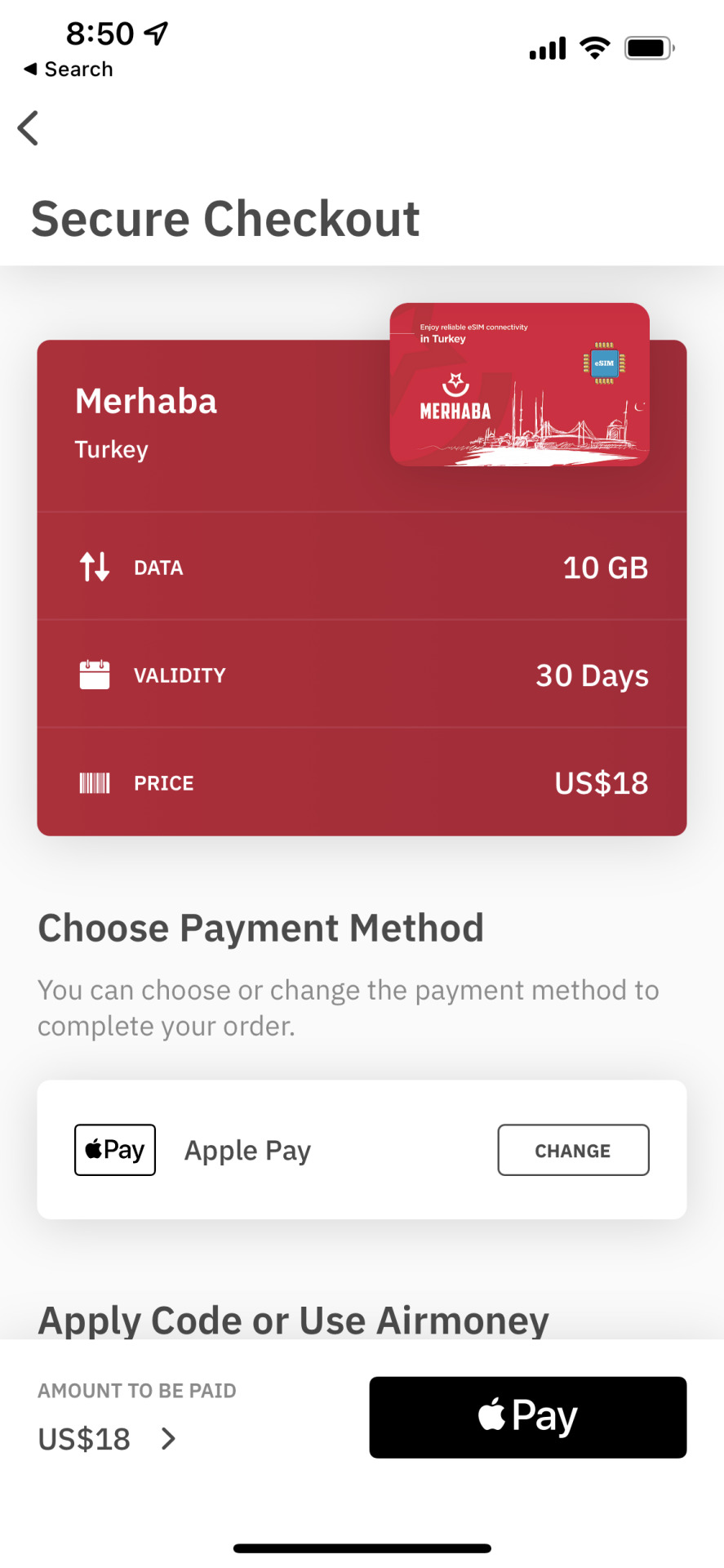
---
Step 2: Order confirmation

---
Step 3: A button appears to install the eSIM after purchase
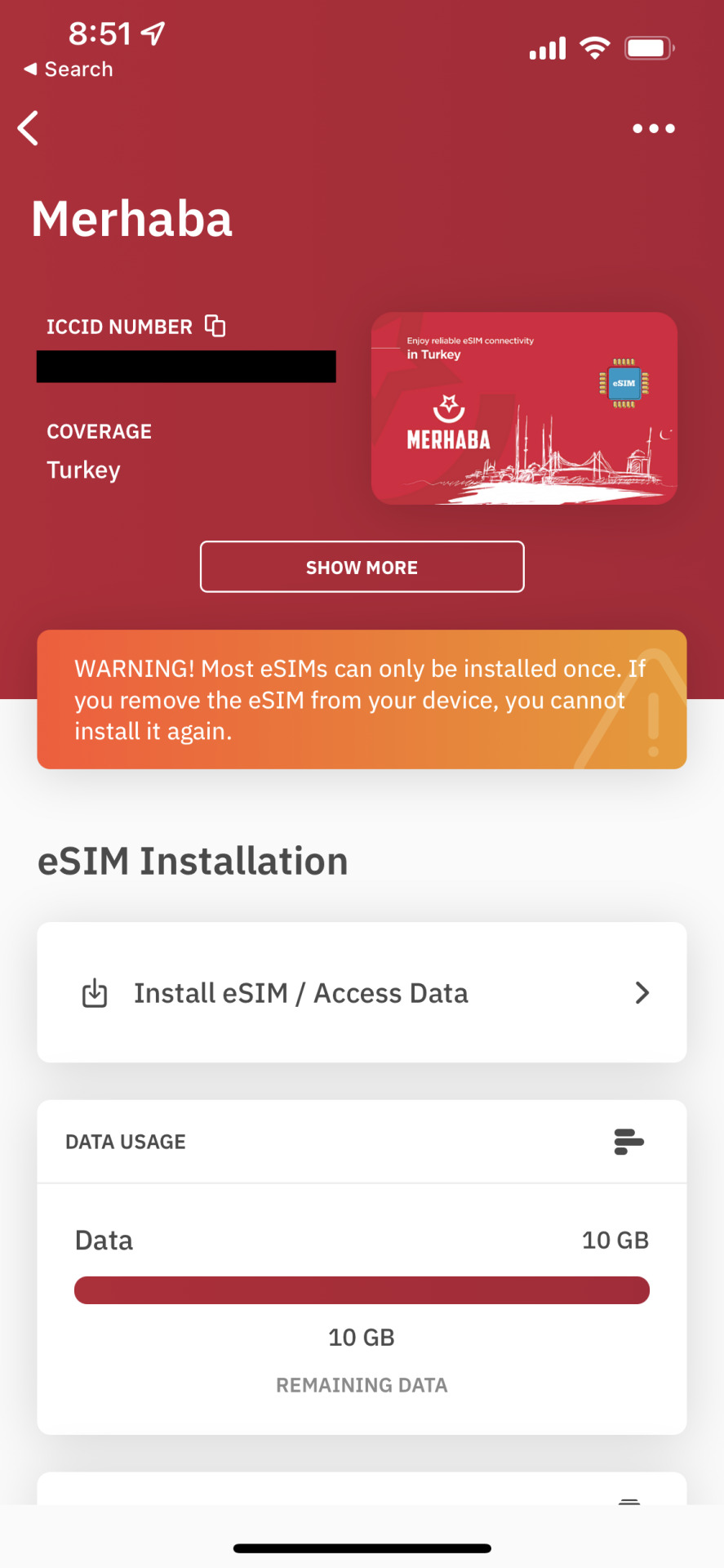
---
Step 4: a few pages of tips provided by Airalo

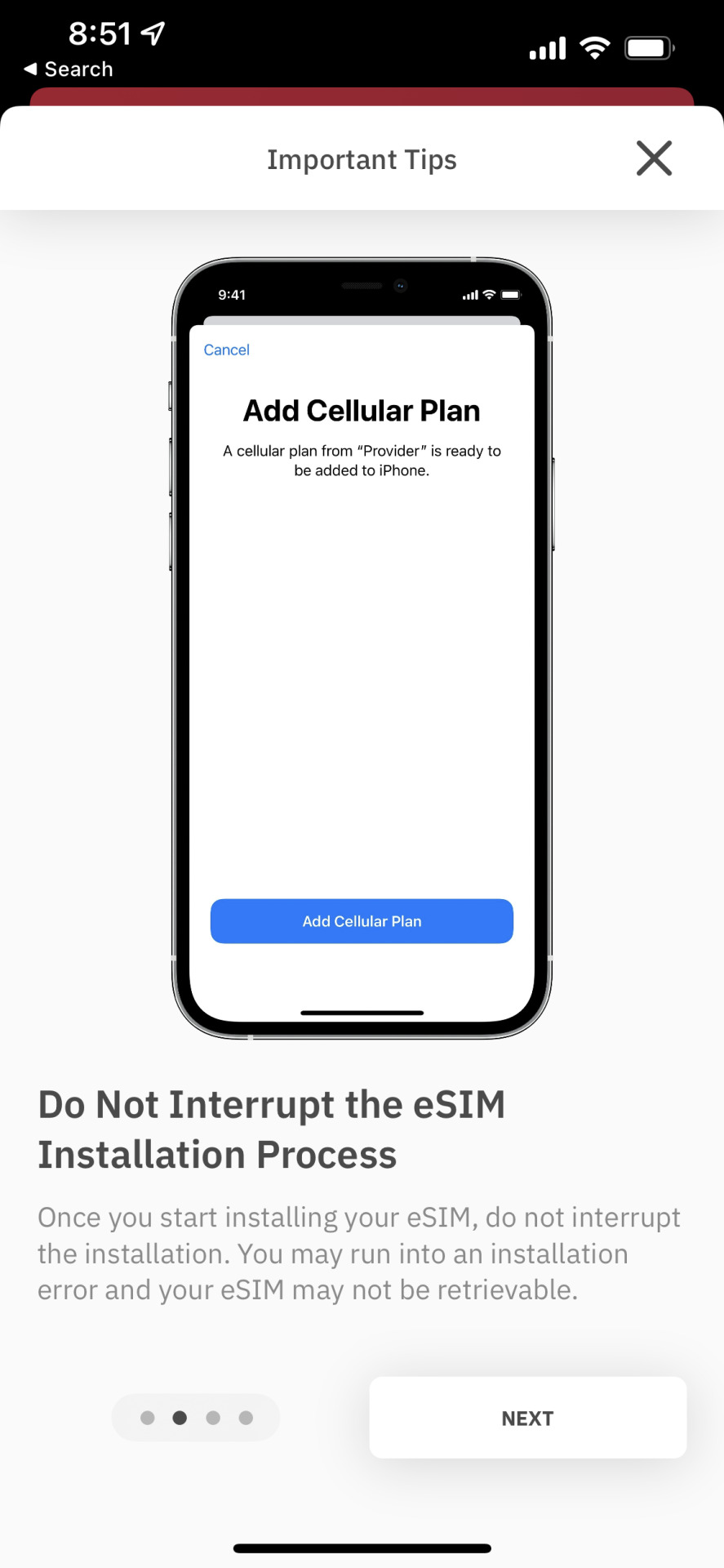
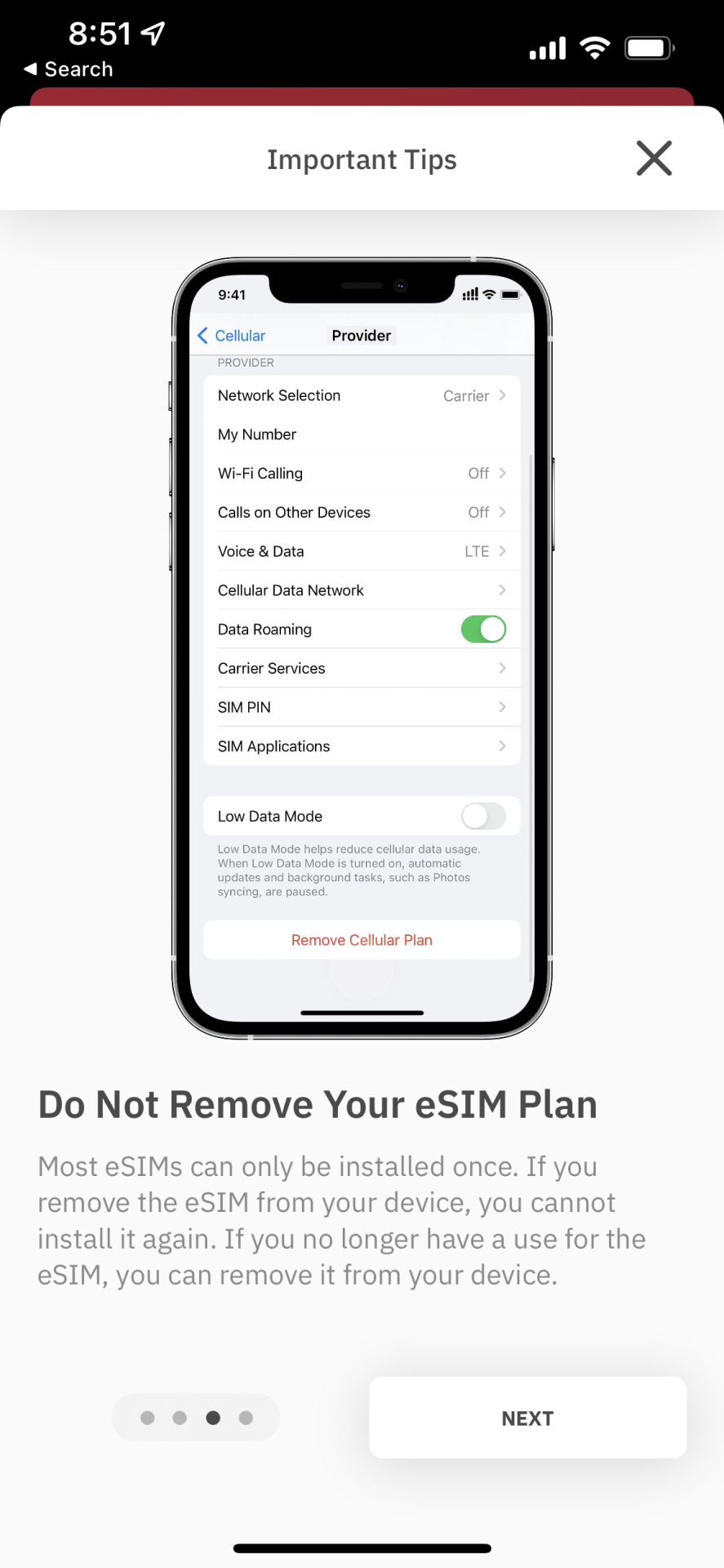

---
Step 5: More instructions reiterating the previous visual guide. Tap “Install eSIM” to continue and actually get this data on the road!
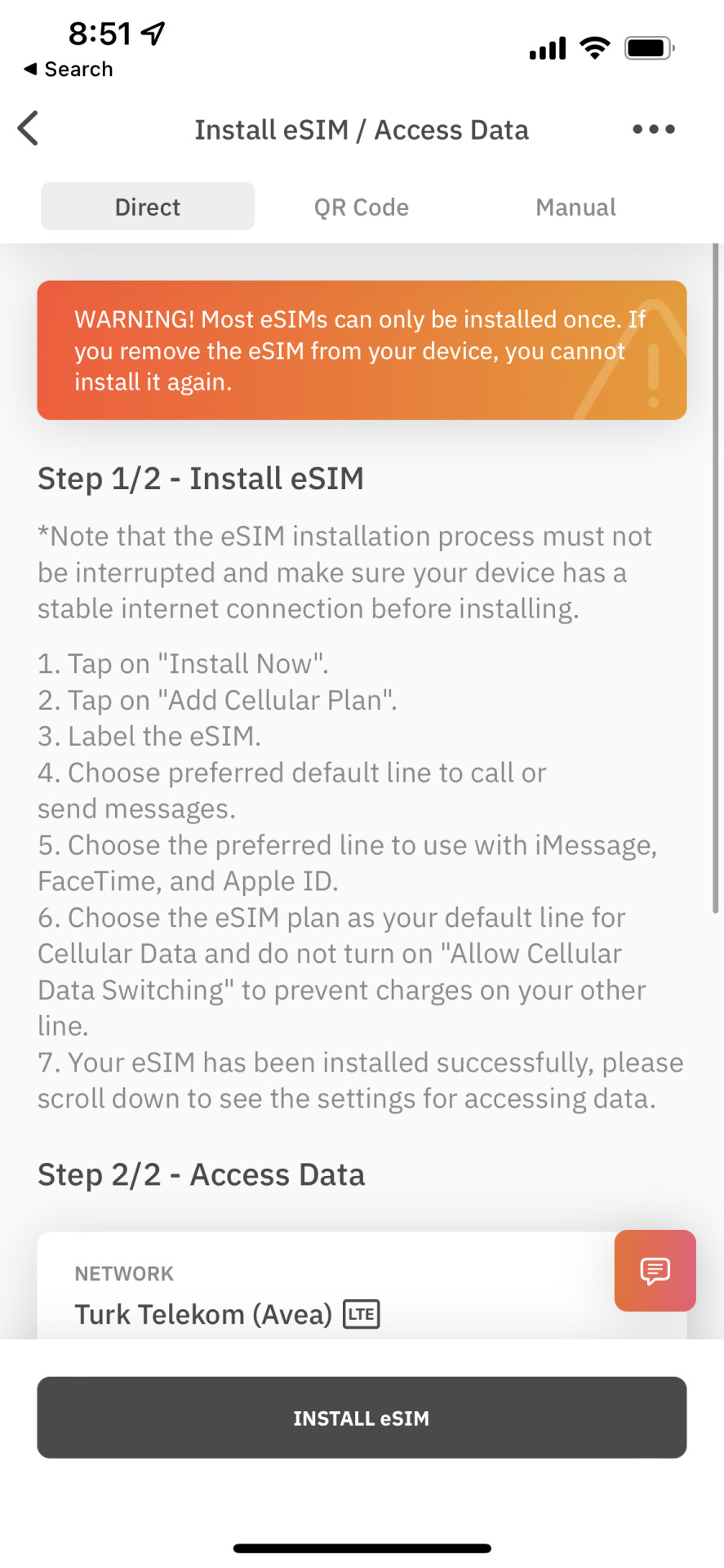
---
Step 6: iOS prompts the eSIM installation

---
Step 7: this screen seems a bit redundant and could be merged with the previous one.
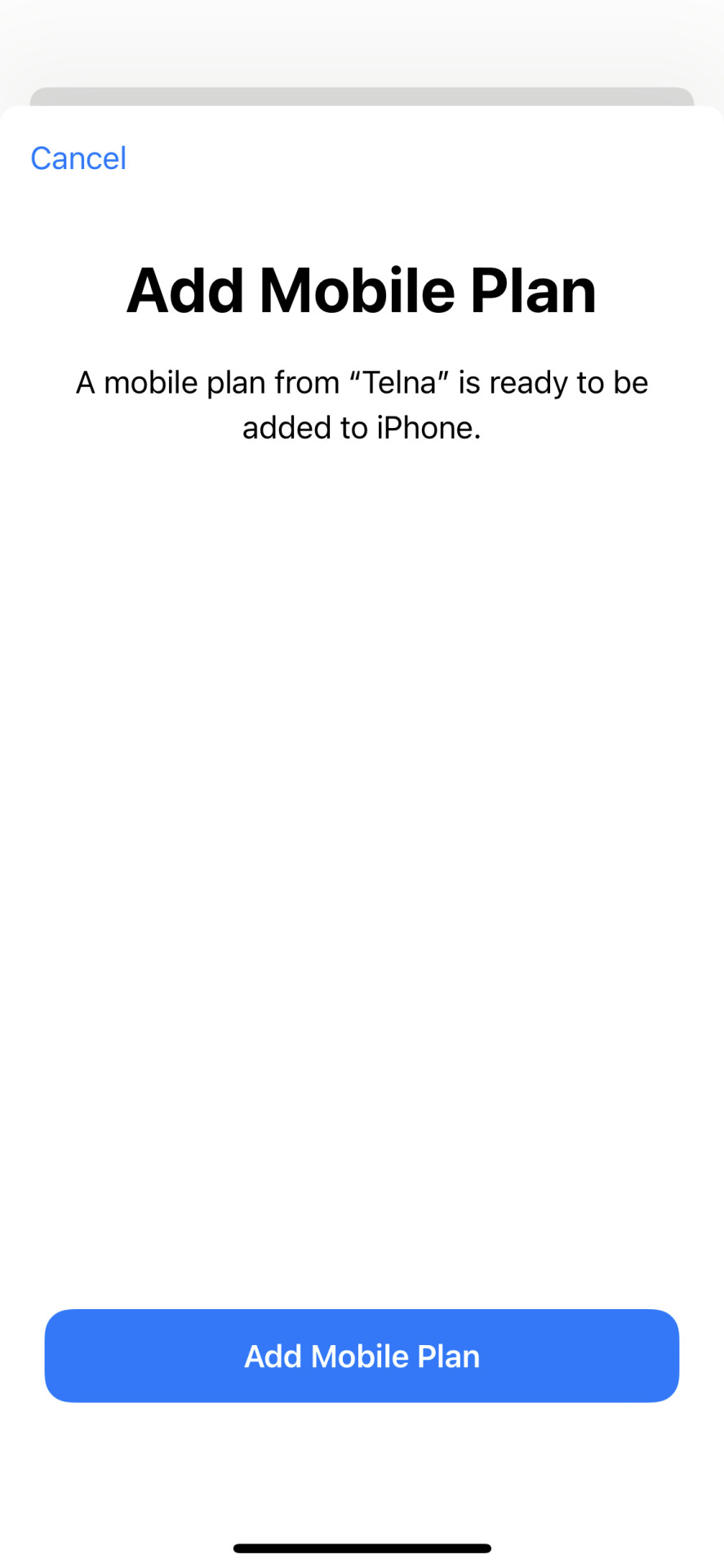
---
Step 8: You could label your SIMS “home” and “away” or anything you’ll remember later on. This would likely be more important if you could install more than on eSIM at a time.

---
Step 9: Which number do you want to use for calls or messages? Defaults to your physical SIM, with it presumed you’ll use the eSIM just for the data
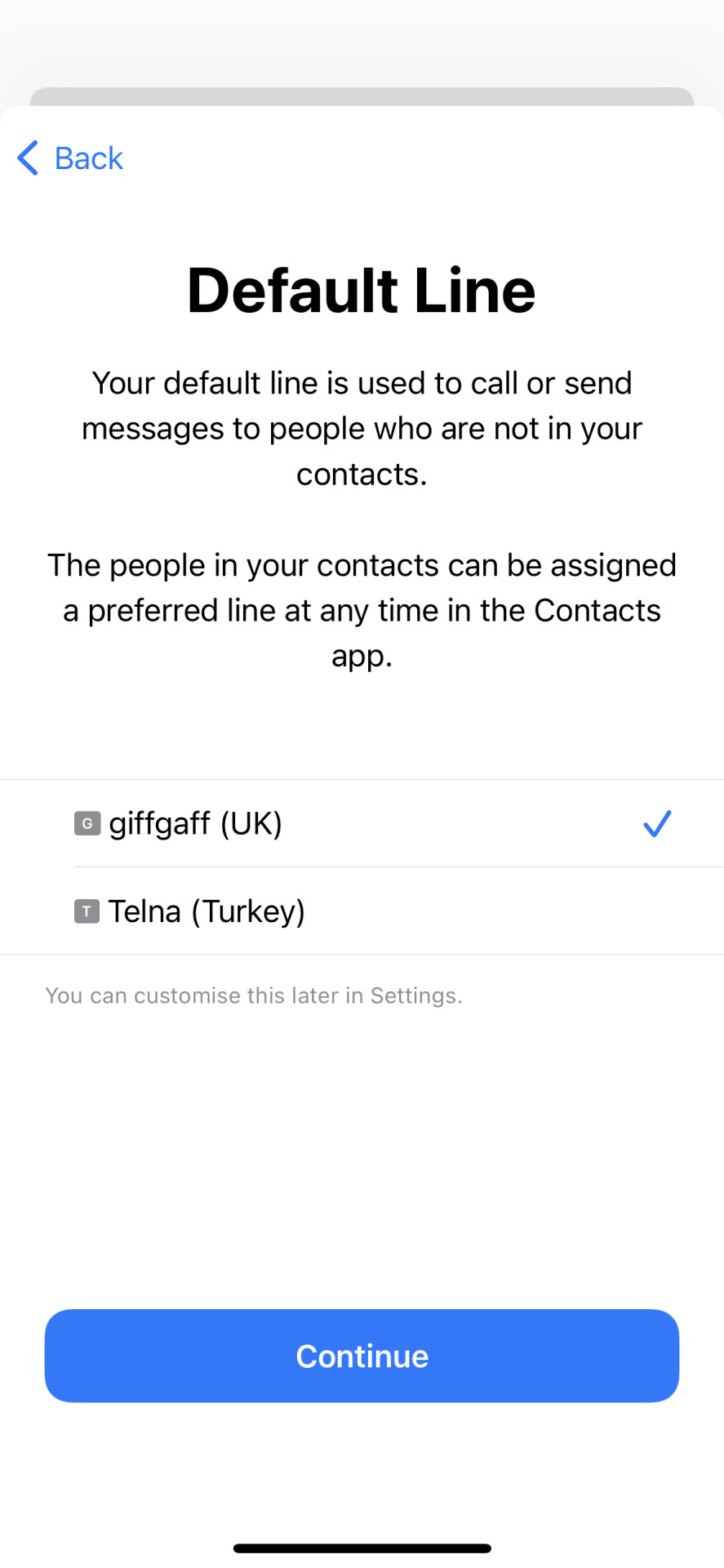
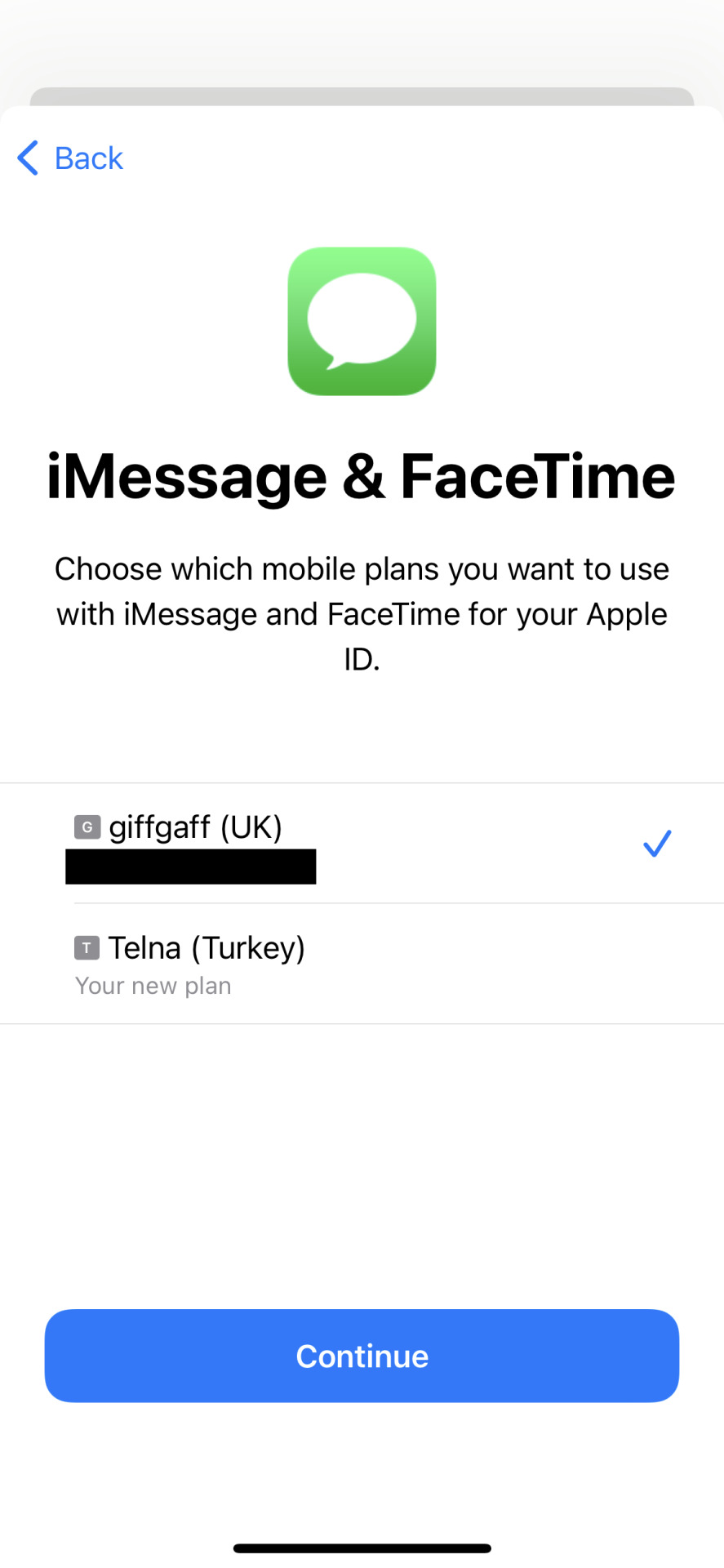
---
Step 10: the important step! You’ll want to use the eSIM for data. If setting up before you arrive in your destination, leave this on your normal SIM, and change in Settings once you land.
These eSIMs will only work in the country specified at purchase.

There’s not much more I can add here. eSIM is great for travel. Airalo is great. There’s likely going to be more good apps and ways to do this in future, but for now it’s my recommendation.
If you use this link to register your account, you will receive a $3 USD sign-up credit, or you can just type my referral code in the app: JEREMY0461. Or if you have a friend using Airalo, ask them for their referral code and they will get the $3 instead!
Happy roaming.
3 notes
·
View notes
Text
NCC X IPLOOK: Training meeting about satellite communication

Advanced technology is always the trump card in the telecom industry.
As a leading end-to-end mobile core network solution vendor, except for 5G Core Network (5GC), 4G Core Network (EPC) and related core network solutions, IPLOOK also keeps developing innovative solutions with the latest technologies such as satellite network (SATNET) and 6G technology.
Training meeting about 6G technology and satellite communication
Themed by "6G Technology and Satellite Communication", IPLOOK and the Nigerian Communications Commission (NCC) held a training meeting on June 28th, 2022.
IPLOOK' s technical team led by Dr. Wang Dan and Mr. Owen Ouyang gave a presentation, including four major parts: the introduction of satellite communication (Satcom), the current status of Satcom, the satellite solution integrated with cellular network and AI technology, as well as satellite orbits in detail.
NCC showed great interest in IPLOOK’ s satellite solution, which releases a signal that the meeting is a golden opportunity for IPLOOK to assist Nigeria to build the 4G/5G and even 6G network.
IPLOOK satellite solution
Satellite communications (SatComs) have entered a period of renewed interest motivated by technological advances and nurtured through private investment adventures.

Various applications and customized requirements entitle a new communication evolution with the ability of low latency, high throughput, intensive computing performance and artificial intelligence. Satellite communication system becomes a new option for operators and enterprises to guarantee seamless coverage with high performance in remote regions.
The advantages of IPLOOK satellite communication system
· Rich available spectrum resources
· No geographical environment constraints (strong mobility)
· Flexible communication mode
...
IPLOOK will keep innovating new technologies with our professional technical team all the time!
1 note
·
View note
Text
5G Technology Market Worth $241.5 Billion by 2029
Meticulous Research®—a leading global market research company, published a research report titled, ‘5G Technology Market by Component (Hardware, Software, and Services), Connectivity (Enhanced Mobile Broadband (eMBB), Massive Machine Type Communication (mMTC), Ultra-Reliable and Low-Latency Communication (URLLC)) -Global Forecast to 2029.’
According to this latest publication from Meticulous Research®, the global 5G technology market is expected to reach $241.5 billion by 2029, at a CAGR of 42.2% during the forecast period.
The 5G technology market is driven by the massive growth in mobile data traffic volumes over 4G networks, the need for ultra-low latency network connectivity, and the growing investments in the 5G network. However, delays in the standardization of spectrum allocation may restrain the market's growth to some extent.Connected factories, automation, and smart cities initiatives in developed and developing regions worldwide are expected to offer significant growth opportunities for the 5G technology market.
Meticulous Research® has segmented this market by component, connectivity, and geography to provide efficient analysis. The study also evaluates industry competitors and analyzes the regional and country-level markets.
Based on component, in 2022, the hardware segment is expected to account for the largest share of the 5G technology market. The large market share of this segment is attributed to the increasing need to reduce OPEX and CAPEX, the growing robust deployment of 5G RAN with several small cells and macrocell base stations, and the increasing need to implement virtual RAN among network service providers to reduce network complexities.
Based on connectivity, in 2022, the enhanced mobile broadband (eMBB) segment is expected to account for the largest share of the 5G technology market. The large market share of this segment is attributed to the growing demand for high-speed and low-latency data networks for residential and commercial applications, such as video conferencing, virtual meetings, and virtual reality (VR) & augmented reality (AR) gaming. In addition, the rising penetration of smartphones and the need for high bandwidth to provide reliable communication to wireless devices are enhancing the growth of this segment.
Based on geography, in 2022, Asia-Pacific is expected to account for the largest share of the 5G technology market. The presence of prominent key players in the region is expected to contribute to its high revenue share and the rapid economic growth in major countries such as China, Japan, India, and South Korea. In addition, businesses and governments in this region have shown a high inclination toward commercializing next-generation 5G networks, propelling the demand for 5G technology over the forecast period. Moreover, the conducive environment for start-ups and the rising demand for ultra-low latency are also expected to boost the growth of this regional market over the forecast period.
The key players operating in the 5G technology market are Nokia Corporation (Finland), Cisco Systems, Inc. (U.S.), Huawei Technologies Co., Ltd. (China), Telefonaktiebolaget LM Ericsson (Sweden), Qualcomm Technologies, Inc. (U.S.), Ciena Corporation (U.S.), Verizon Communications Inc. (U.S.), Intel Corporation (U.S.), Deutsche Telekom AG (Germany), Samsung Electronics Co., Ltd. (South Korea), Extreme Networks (U.S.), DISH Network Corporation (U.S.), NEC Corporation(U.S.), Parallel Wireless, Inc. (U.S.), AT&T (U.S.), Fujitsu Limited (Japan), Mavenir Systems, Inc. (U.S.), ZTE Corporation (China), Comba Telecom Systems Holdings Ltd. (China), and Crown Castle (U.S.).
Download Sample Copy Here: https://www.meticulousresearch.com/download-sample-report/cp_id=5327
Key questions answered in the report-
Which are the high-growth market segments in terms of component, connectivity, and geography?
What is the historical market for 5G technology across the globe?
What are the market forecasts and estimates for the period 2022–2029?
What are the major drivers, restraints, and opportunities in the global 5G technology market?
Which are the major players in the global 5G technology market, and what market share do they hold?
How is the competitive landscape?
What are the recent developments in the global 5G technology market?
What are the different strategies adopted by the major players in this market?
What are the geographic trends and high-growth countries?
Which are the local emerging players in the global 5G technology market, and how do they compete with the other players?
Contact Us:
Meticulous Research®
Email- [email protected]
Contact Sales- +1-646-781-8004
Connect with us on LinkedIn- https://www.linkedin.com/company/meticulous-research
#5G Technology Market#5th Generation Technology#5g Networks#5g Wireless Technology#Mobile Network Technology#5G Market
0 notes
Text
what does lte vpn mean
🔒🌍✨ Get 3 Months FREE VPN - Secure & Private Internet Access Worldwide! Click Here ✨🌍🔒
what does lte vpn mean
LTE definition
LTE, or Long-Term Evolution, is a standard for wireless broadband communication of mobile devices and data terminals. It is based on the GSM/EDGE and UMTS/HSPA network technologies, increasing the capacity and speed using a different radio interface together with core network improvements.
One of the primary objectives of LTE is to increase the capacity and speed of wireless data networks. It achieves this by using a different radio interface along with various core network improvements. LTE offers significantly higher peak data rates, lower latency, and more efficient use of the radio spectrum compared to previous mobile network technologies.
The LTE standard is continually evolving, with various releases introducing new features and enhancements. These releases are typically referred to as LTE Advanced (LTE-A) and LTE Advanced Pro (LTE-A Pro). LTE-A offers further improvements in data rates and network capacity by utilizing techniques such as carrier aggregation, which allows multiple LTE carriers to be used together to increase bandwidth.
LTE has become the dominant technology for 4G mobile networks globally, offering high-speed internet access to billions of users worldwide. It provides the foundation for various services and applications, including video streaming, online gaming, video conferencing, and internet of things (IoT) devices.
In summary, LTE is a standard for wireless broadband communication that delivers high-speed data access to mobile devices and data terminals. With its continued evolution through releases like LTE-A and LTE-A Pro, LTE remains at the forefront of mobile network technology, supporting the growing demand for data-intensive applications and services.
VPN explanation
Title: Understanding VPNs: A Comprehensive Overview
In the modern digital landscape, where privacy and security concerns loom large, Virtual Private Networks (VPNs) have emerged as essential tools for safeguarding online activities. But what exactly is a VPN, and how does it work?
At its core, a VPN is a service that encrypts your internet connection and routes it through a remote server, effectively masking your IP address and location. This encryption ensures that your data remains secure and private, shielding it from prying eyes, such as hackers, government surveillance, or even your Internet Service Provider (ISP).
But the benefits of VPNs extend beyond mere privacy protection. By connecting to a VPN server located in a different geographic region, users can bypass censorship restrictions and access geo-blocked content. This functionality is particularly valuable for individuals traveling abroad or those residing in countries with strict internet regulations.
Furthermore, VPNs offer enhanced security when using public Wi-Fi networks, which are notorious hotspots for cyber threats. By encrypting your connection, VPNs prevent malicious actors from intercepting sensitive information, such as passwords or financial details.
Choosing the right VPN provider is crucial, as not all services are created equal. Factors to consider include encryption protocols, server locations, connection speed, and privacy policies. Additionally, it's essential to opt for a VPN that does not log user activity, ensuring true anonymity.
In conclusion, VPNs are indispensable tools for maintaining privacy, security, and unrestricted access to online content. By encrypting internet traffic and masking IP addresses, VPNs empower users to browse the web with confidence, regardless of their location or the nature of the network they're connected to.
LTE VPN comparison
LTE VPN Comparison: Finding the Right Fit for Secure Mobile Connectivity
In an age where connectivity is paramount, virtual private networks (VPNs) have become indispensable tools for ensuring privacy and security online. For users reliant on LTE networks for their mobile internet needs, selecting the right VPN can make a significant difference in safeguarding their data and browsing activities.
When comparing VPN options tailored for LTE connectivity, several factors come into play. Firstly, speed is crucial, as LTE users prioritize fast and reliable connections. VPNs with optimized servers and protocols can help minimize latency and maintain high speeds, ensuring seamless browsing and streaming experiences.
Moreover, security features are non-negotiable when evaluating VPNs for LTE usage. Advanced encryption protocols, such as AES-256, along with secure tunneling protocols like OpenVPN or IKEv2/IPsec, are essential for protecting data transmitted over LTE networks from potential threats and cyberattacks.
Furthermore, VPN providers offering robust privacy policies and a strict no-logs approach are preferred, as they ensure that user activities remain confidential and anonymous. Additionally, features like kill switches and DNS leak protection further enhance security by preventing data exposure in case of VPN disconnections.
Another crucial aspect to consider in an LTE VPN comparison is compatibility across devices and platforms. Whether accessing the internet via smartphones, tablets, or laptops, users need VPN solutions that seamlessly integrate with their preferred devices and operating systems.
Lastly, pricing and subscription plans play a significant role in the decision-making process. While some VPNs offer free or budget-friendly options, premium providers may justify their higher costs with additional features and enhanced performance.
In conclusion, selecting the right VPN for LTE connectivity requires careful consideration of factors such as speed, security, compatibility, and pricing. By conducting thorough comparisons and assessing individual needs, users can find the ideal VPN solution to ensure a safe and seamless online experience over LTE networks.
Benefits of LTE VPN
Title: Unlocking the Potential: The Benefits of LTE VPN
In today's fast-paced digital landscape, connectivity is paramount. As more businesses and individuals rely on mobile devices for work, communication, and entertainment, the need for secure and reliable internet access has never been greater. LTE VPN, or Long-Term Evolution Virtual Private Network, emerges as a powerful solution, offering a multitude of benefits that cater to modern connectivity needs.
Enhanced Security: LTE VPN encrypts data transmitted between the user's device and the VPN server, ensuring that sensitive information remains secure from potential threats such as hackers, identity thieves, and malicious software. This level of encryption is particularly crucial for businesses handling confidential data and individuals concerned about their online privacy.
Geo-restriction Bypass: Many websites and online services impose geo-restrictions, limiting access based on the user's geographical location. LTE VPN allows users to bypass these restrictions by masking their IP addresses with one from the VPN server location, granting access to geo-blocked content and services from anywhere in the world.
Improved Performance: By routing internet traffic through VPN servers, LTE VPN can optimize connection speeds and reduce latency, resulting in smoother and more responsive online experiences. This is especially beneficial for activities such as video streaming, online gaming, and video conferencing, where high-speed, low-latency connections are essential.
Flexibility and Mobility: Unlike traditional VPNs that rely on fixed internet connections, LTE VPN leverages mobile networks, providing users with unparalleled flexibility and mobility. Whether working from a remote location, traveling abroad, or simply on the go, users can stay connected to their VPN without being tethered to a specific location or network.
Cost-effectiveness: LTE VPN eliminates the need for expensive dedicated lines or hardware, making it a cost-effective solution for businesses and individuals seeking reliable and secure connectivity without breaking the bank.
In conclusion, LTE VPN offers a host of benefits, including enhanced security, geo-restriction bypass, improved performance, flexibility, mobility, and cost-effectiveness. By leveraging the power of mobile networks, LTE VPN empowers users to stay connected and protected wherever they go in today's digital world.
Usage of LTE VPN
A LTE VPN, or Long-Term Evolution Virtual Private Network, is a secure network connection that utilizes the LTE mobile network to provide users with a safe and encrypted communication channel. This technology allows individuals and businesses to access the internet securely while using a cellular data connection.
One of the primary advantages of using a LTE VPN is the enhanced security it offers. By encrypting data traffic, LTE VPNs help protect sensitive information from potential cyber threats, such as hackers or data breaches. This is particularly important for businesses that handle confidential information or for individuals who prioritize online privacy.
Additionally, LTE VPNs enable users to access restricted content or websites that may be blocked in certain regions. This can be beneficial for individuals traveling abroad or for businesses with employees working remotely who need access to specific online resources.
Moreover, LTE VPNs can also improve network performance by providing a faster and more stable connection. This is especially useful in areas where traditional internet connections may be unreliable or unavailable.
Overall, the usage of LTE VPN can provide users with improved security, privacy, and accessibility while they are connected to the internet through a cellular data network. Whether for personal or business use, LTE VPN technology offers a reliable and efficient solution for safeguarding online communications.
0 notes
Text
Key Players and Market Dynamics in APAC's Mobile Broadband Market
The APAC mobile broadband market is characterized by a dynamic ecosystem of key players spanning mobile network operators (MNOs), technology vendors, device manufacturers, content providers, and regulatory bodies.

Buy the Full Report for the APAC Mobile Broadband Market Forecast
Download a Free Sample Report
Here's an overview of the key players and market dynamics shaping the APAC mobile broadband landscape:
1. Mobile Network Operators (MNOs):
China Mobile: The world's largest mobile operator by subscribers, China Mobile dominates the Chinese market and plays a pivotal role in driving 5G deployment and mobile broadband expansion in China.
NTT Docomo: Japan's leading mobile operator, NTT Docomo, is at the forefront of 5G innovation and network development, offering high-speed mobile broadband services and advanced digital solutions.
SK Telecom: A major player in South Korea, SK Telecom is known for its early adoption of 5G technology and aggressive investment in network infrastructure, content partnerships, and IoT initiatives.
Reliance Jio: Disrupting the Indian telecom market with its low-cost data plans and extensive 4G network coverage, Reliance Jio has rapidly gained market share and propelled mobile broadband adoption in India.
2. Technology Vendors and Infrastructure Providers:
Huawei: A leading global provider of telecommunications equipment and solutions, Huawei plays a critical role in 5G infrastructure deployment and network modernization projects across the APAC region.
Ericsson: Another major player in the telecom equipment market, Ericsson collaborates with MNOs in APAC to deploy 5G networks, enhance mobile broadband performance, and deliver cutting-edge technologies.
Nokia: Nokia provides end-to-end network solutions and services to MNOs in APAC, focusing on 5G readiness, network optimization, and digital transformation initiatives.
3. Device Manufacturers:
Samsung: As one of the largest smartphone manufacturers globally, Samsung holds significant market share in APAC and offers a wide range of 5G-enabled devices to cater to the growing demand for mobile broadband.
Apple: The iPhone maker commands a loyal customer base in APAC markets and drives mobile broadband adoption through its flagship smartphones, which support advanced connectivity features and high-speed data access.
Xiaomi, Oppo, Vivo: Chinese smartphone brands such as Xiaomi, Oppo, and Vivo are prominent players in the APAC region, offering affordable yet feature-rich devices with 5G capabilities to appeal to diverse consumer segments.
4. Content Providers and OTT Services:
Tencent, Alibaba: Chinese tech giants Tencent and Alibaba offer a wide range of digital services, including messaging apps, e-commerce platforms, online video streaming, and gaming, driving mobile broadband usage and engagement.
Netflix, YouTube: Global OTT video streaming platforms like Netflix and YouTube are popular among APAC consumers, contributing to increased mobile broadband consumption for streaming high-definition video content.
TikTok: The short-form video app TikTok has gained immense popularity in APAC markets, driving demand for mobile broadband connectivity for video sharing, social media engagement, and user-generated content.
5. Regulatory Bodies and Government Initiatives:
Telecommunications Regulatory Authorities: Regulatory bodies in APAC countries oversee spectrum allocation, licensing, competition policies, and consumer protection regulations to ensure fair market practices and promote investment in mobile broadband infrastructure.
Government Initiatives: Governments in APAC implement policies and initiatives to promote digital inclusion, improve broadband access in rural and underserved areas, and facilitate 5G deployment through spectrum auctions, infrastructure subsidies, and regulatory reforms.
Market Dynamics:
5G Deployment and Adoption: The rollout of 5G networks drives mobile broadband growth, offering faster speeds, lower latency, and enhanced connectivity for consumers and businesses.
Data Consumption Trends: Increasing demand for mobile data services, fueled by video streaming, social media, gaming, and IoT applications, propels mobile broadband usage and revenue growth.
Competition and Pricing Strategies: Intense competition among MNOs leads to aggressive pricing strategies, data plan promotions, and value-added services to attract and retain subscribers in saturated markets.
Content and Service Innovation: Content providers and OTT platforms drive innovation in mobile broadband services, offering personalized content, interactive experiences, and bundled offerings to enhance user engagement and loyalty.
Regulatory Environment: Regulatory policies and spectrum management decisions influence investment priorities, network deployment timelines, and market competition dynamics in the APAC mobile broadband market.
In summary, the APAC mobile broadband market is characterized by a diverse ecosystem of key players, technological advancements, and regulatory dynamics driving growth and innovation in mobile communications and digital connectivity across the region.
0 notes
Text
Mobile phone coverage boost for the Lake District
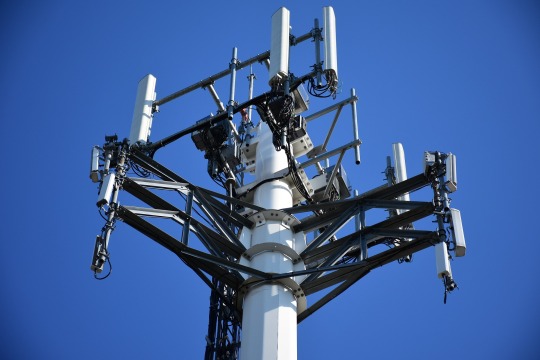
Rural towns and villages in the Lake District have become the first in England to benefit as government delivers on its plan to improve 4G mobile coverage in hard-to-reach areas.
The first of 83 government-funded mast upgrades planned in England were switched on today (9 April) near the market town of Keswick in Cumbria.
It means dozens of local businesses and community organisations in areas including Naddle, Thirlmere and St Johns-in-the-Vale, can now take advantage of better connectivity thanks to the Shared Rural Network – a £1 billion programme brokered by the government and joint-funded with mobile network operators aimed at increasing mobile coverage in rural areas.
The boost has been carried out by upgrading existing mobile masts which previously only connected EE customers and anyone making 999 calls, meaning communities can benefit from improved connectivity without the visual impact involved when building new masts.
It will enable residents, tourists and businesses to access reliable 4G coverage from all four mobile network operators – EE, VMO2, Three and Vodafone – closing the connectivity blackhole and boosting economic growth in the region.
Digital Infrastructure Minister Julia Lopez said:
We’re dialling up fast and reliable mobile coverage across the UK through the Shared Rural Network. Our latest upgrade in the Lake District is one of many we’re working hard to deliver as part of our mission to clamp down on the headache of mobile ‘not spots’.
The coverage boost will provide endless benefits for communities and visitors, ensuring people stay connected on the go, enabling people to work more efficiently and attracting vital investment to the rural economy.
Ben Roome, CEO of Digital Mobile Spectrum Limited (DMSL) said:
In England, since the Shared Rural Network was announced in March 2020, 4G coverage from all four operators has expanded across an additional 5,400 square kilometres – an area larger than Norfolk. As more shared mobile sites go live, people visiting and living in rural areas will see better 4G service thanks to this programme.
Today marks an important milestone in the rollout of the Shared Rural Network aiming to bring reliable 4G signal to 95 per cent of UK landmass by the end of 2025.
Since the Shared Rural Network programme began in 2020, an additional 13,000 sq km – roughly the size of Northern Ireland or two million football pitches – have been able to receive coverage from all four operators, EE, Three VMO2 and Vodafone.
The government and the UK’s four mobile network operators aim to provide coverage to an additional 280,000 premises and 16,000km of the UK’s roads.
The programme also aims to improve geographic coverage to 79% of Areas of Natural Beauty, up from 51% before the programme launched, and 74% of National Parks up from 41%, benefitting millions of visitors every year.
The UK government is investing around £500 million into the Shared Rural Network, including £184 million to upgrade Extended Area Service (EAS) masts to provide coverage from all four mobile operators. Currently, commercial coverage from EAS masts is only available from EE – the operator responsible for the Emergency Services Network. The remaining government funding will go towards eliminating total ‘not spots’, places where there is no coverage from any mobile operator.
The telecoms sector is also investing over £500 million to target partial ‘not spots’, where customers can only access 4G if they’re signed up with a mobile network operator that is active in the area. This part of the programme has already delivered significant coverage improvements across the UK, including in the areas of Shetland, Yorkshire, Fermanagh and Devon.
Read the full article
0 notes